Mizuno Wave Rider Neo vs Wave Rider 24 Comparison Shoe Review
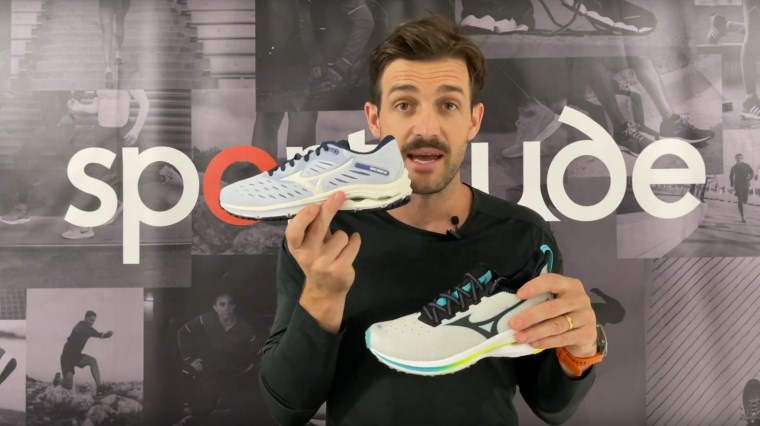
Josh reviews the Mizuno Wave Rider Neo running shoes, a confidence-inspiring ride for neutral runners looking to clock up the kilometres and potentially shift the pace up a gear. It weighs in lighter and offers a plusher and more responsive underfoot sensation compared to its predecessor, the Mizuno Wave Rider 24.
Mizuno have boosted the traction and durability of the outsole with crystallised rubber protecting the asset of the running shoe, being the full-length Enerzy foam midsole – Mizuno’s lightest and softest cushioning technology yet.
The woven upper has been refined for comfort and performance with a supportive structure up top to lock you onto the platform. It features a modern flared heel design for reduced irritation around the back of your Achilles and minimal heel slippage.
A one-piece bootie construction creates an effortless, secure feel while strategic eyelets allow you to dial in the fit of the laces for a distraction-free run.
Check out the review with full transcript below.
Hey guys, Josh here from Sportitude Running and today we have a new shoe to introduce to you at home and it is the Mizuno Wave Rider Neo. This shoe has just landed in Australia in the front half of 2021.
This little guy has been built on a couple of decades of developments from the Mizuno department regarding the Wave Rider franchise. The objective of this shoe is to create a slightly lighter and more propulsive feel underneath the foot and they certainly have managed to nail the brief.
They have made adjustments in the whole shoe across the outsole, midsole and upper. In today's review we're going to dive into all those changes, compare it to the Mizuno Wave Rider 24 and profile the foot type that could be considering this shoe. Without further ado let's get stuck in.
Runner Profile

Just to dial in on the functionality of this shoe, it is a high mileage running shoe and it is built on a neutral platform. Nothing has changed with regards to the Wave Rider Neo in reference to the foot type that could be considering this shoe.
A neutral foot has a static position with a little bit of real estate between the arch and the ground. It applies to the runner that comes through their gait transition, lands on their heel or midfoot first and as they come through to the toe-off phase, we don't tend to see much tilt towards the medial side. The pressure is either through the central part of the foot or we may see a little bit of what we classify as under pronation. This shoe will certainly cater for that foot type quite well.
From time to time when we're fitting people in store, we see a static position with a flatter arch come through that still runs in a neutral running shoe. You can see the difference between the two foot types, one with a high arch and a bit of real estate between the arch and the ground and the other with a slightly more collapsed arch on that medial side.
However, if the runner has a flatter foot type but there's not a drastic drop off in that medial side and only minimal shin rotation in their running gait, that runner could be considering a neutral running shoe as well.
When it comes to the acute variances with foot type, you'll be best off getting your foot checked out from a professional store or contact Sportitude Running and we'll take care of you.
Let's get into this shoe review because there's a lot to like about the Mizuno Wave Rider Neo. As I touched on in my introduction, Mizuno have gone back to the drawing board and changed the outsole, midsole and upper of this shoe in comparison to the Wave Rider 24.
In some respects when I look at two shoes like this and they're sitting on the wall, I ask the question of why. Why would you have two shoes that are pretty similar to each other? The reason they've done this is because they're targeting a different runner.
Your Mizuno Wave Rider 24 runner is someone that wants a slightly lighter high mileage shoe with decent cushioning underneath the forefoot. The overall fit and function in this shoe is going to give them confidence mile after mile. They may not like the weight of shoes like the Mizuno Wave Sky in the Mizuno range and they want something that feels a little bit easier on the foot but still is going to offer ample protection underneath their body.
Essentially, Mizuno have achieved the same thing with the Mizuno Wave Rider Neo. However, they’ve tinkered every part of the engineering of this shoe being the outsole, midsole and the upper.
Outsole
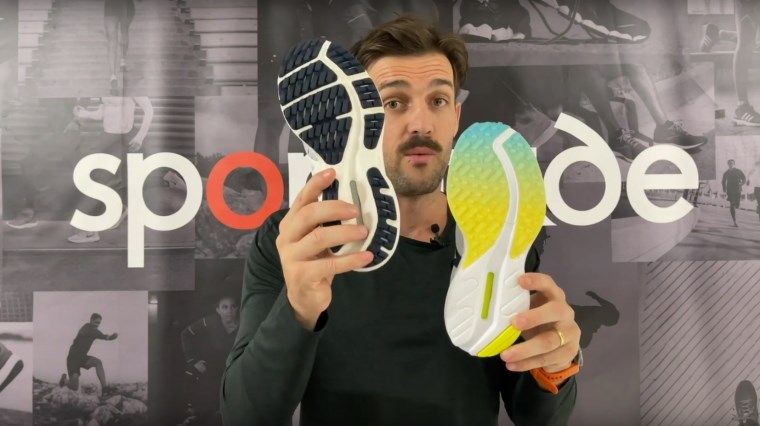
Compared to the Mizuno Wave Rider Neo, the forefoot of the Mizuno Wave Rider 24 has a traditional blown rubber material that it is slightly lighter and softer. It’s durable enough for a mileage shoe but what we've got going on with the Wave Rider Neo is a crystallised rubber concept. The idea is all to do with what's happening in the midsole which we’ll get to in two ticks.
The outsole protection configuration on the Mizuno Wave Rider Neo is pretty durable but it's also going to offer a lot more grip. If you're thinking about this runner that's going to be looking at the Wave Rider Neo, they're potentially going to be the person that's picking up the pace a little bit more.
When you’re picking up the pace, you want a bit more confidence on your foot placement with the ground. Having more grip on that bitumen or pavement surface is going to provide the runner more confidence on connection with the ground.
As you're coming through to the outsole at the back lateral part of the heel, there is a little carbon rubber piece to give a bit of protection for that runner that does come down heel first inside this shoe.
There is an element of carbon rubber which is your traditional rubber, however you can see that it's considerably less underneath the foot compared to the Wave Rider 24. By having less rubber, Mizuno have reduced the weight on the outsole.
Midsole
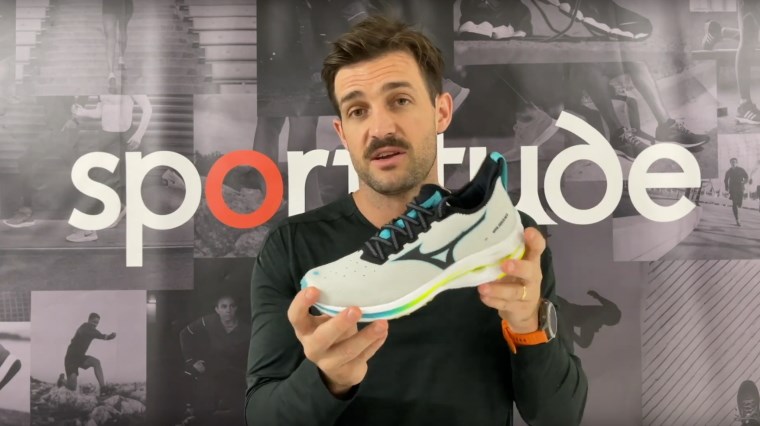
Let's get talking about the midsole because the concept of the outsole has a lot to do with the midsole.
A couple of seasons ago Mizuno engineered and introduced their Mizuno Enerzy foam, their lightest and softest foam yet. When we're looking at the Wave Rider series and the Wave Rider 24, that foam is between the Wave Plate and the ground both on the medial and lateral side. It's strategically placed up until this midfoot section, so it's gradually put into the back of the shoe.
It offers a nice and soft feel underneath the foot on first entry point with the ground. The top layer which sits on top of the Wave Plate and runs right through the forefoot is their patented U4ic cushioning system. It’s light but has an element of density to it which is going to give a bit more response. This will last a fraction longer with regards to the midsole set-up.
Getting back to the Wave Rider Neo, this shoe has a full-length midsole made with Enerzy foam. We have a really soft feel underneath the foot in comparison to the Wave Rider 24 that still has great cushioning, but the Neo is going to be super soft.
Underneath the Wave Plate and on top of the Wave Plate that whole midsole density is Mizuno Enerzy foam which is very soft as I touched on before.
If you're thinking about that for a second, we've got a softer foam underneath the foot. When you put force through your foot where you land it's going to compress a little bit more. Therefore, we need to protect the asset by having a slightly more durable and harder wearing outsole, hence that crystallised rubber set-up underneath the foot. It's going to give a little bit more protection for that Wave Enerzy midsole which is fantastic.
You've got to think about every component of the shoe and what it's going to do for the performance. The Enerzy foam teams up with that Wave Plate that sits in the exact same position as in the Wave Rider 24. They haven't tinkered with the positioning of that Wave Plate on both the medial and lateral side. Also, it's important to note it's essentially the same height off the ground.
While we're talking about heights off the ground, let's touch on the heel-to-toe drop in this shoe. We still have a 12mm heel-to-toe drop in the Wave Rider Neo and that's no different than the Wave Rider 24.
The Mizuno Wave Rider 24 as our statistics have it comes in with a 31mm heel and 19mm forefoot and then we've got a 30mm heel to an 18mm forefoot in the Wave Rider Neo, so a 1mm variance. It’s marginal to be completely fair so you're not going to really notice any change regarding the foot positioning underneath.
The heel-to-toe stack is going to have a similar feel in that static position. However, when you start running in the Mizuno Wave Rider Neo, you're certainly going to notice that softer, smoother ride underneath the foot.
Upper
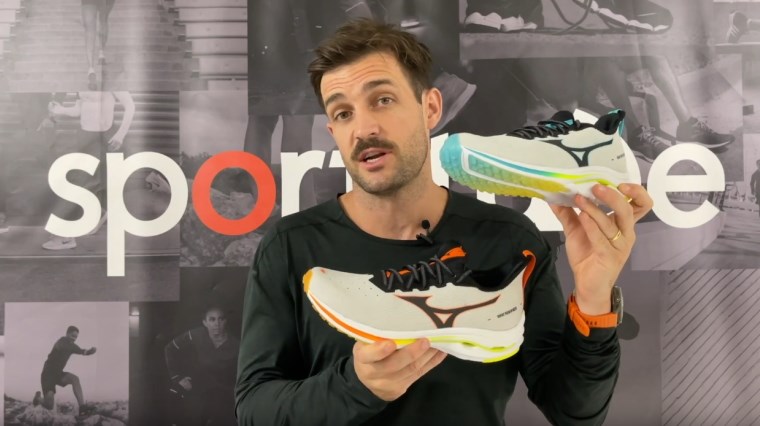
The other probably more noticeable change in this shoe is the upper. Let's get talking about the upper because what I have liked with Mizuno shoes in years gone by is the simplicity of the heel counter set-up.
If you're looking at the Wave Rider 24, I've always liked how Mizuno's executed that internal heel counter. They generally nail that lining on the inside too. They really get that right, they never overcomplicate the amount of foam they have in the back of the heel counter and their uppers have been always really durable and very light and breathable.
They probably had one missed about a decade ago but we won't go there, we'll leave that shoe out of this review. Generally speaking of 24 releases of the Mizuno Wave Rider, 23 have been cherry ripe. I've liked what they've done with the Wave Rider with upper executions.
I was lucky enough to run in a first prototype of the Wave Rider Neo almost a year ago. When I got this shoe, the first thing I noticed was the reduction in weight but also the performance of the upper. I love what they have done with this upper.
We’ve seen a trend with the majority of running shoe brands out there with this ‘elf’ design. They haven't changed the height of the internal heel counter, you just have this flared material which runs up a little bit higher at the back of your Achilles.
With this shoe I got less lift from the back of my heel. I didn't have to worry about doing a heel lock lace which is probably a good thing and I'll touch on the lacing system in two ticks.
When I did my shoelaces up, I got a secure feel at the back of that heel which is fantastic. I automatically have a lot more confidence knowing my foot is going to sit on this platform purely and simply by having a really structured feel up top.
Coming through to the whole upper, it's a bootie construction so the best way to explain that is it's a one-piece construction on top with no separate tongue. With the Wave Rider 24 we have a tongue and then we have a gusseted system which essentially holds the tongue in position on top of the upper.
However, with the Wave Rider Neo, you put your foot in and it is an effortless feel. You must tinker with the laces to get a dialled in fit but that's OK. I felt nice and secure once I got my laces right, but you can see in assistance to getting that fit and feel right, they've really had a think about the lacing system.
You've got high eyelets and low eyelets. You get a more secure fit on top of your arch when you pull your laces in. I liked how that felt, the main reason being is you want to get this lockdown true on top of this shoe because the shoe is a bit softer.
You might be running a bit faster in a shoe like this because it is designed for that slightly quicker runner. You want a secure feel on top of the platform so you can get the maximised performance with what's going on underneath your foot.
The other noticeable thing through the forefoot is there is a mild, almost invisible toe cap. There’s no stitching or seams that could irritate your foot but there is an element of protection around the front half of the toe guard.
Widths
One thing to talk about while we're talking about the upper is the widths in this shoe. It is just a standard width at this point in time, being a D in the men's and B in the women’s model. Generally speaking, when most brands are executing a new shoe they'll play it safe first and just bring it out in the standard widths in both men's and women's.
Who knows in terms of the future plans for Mizuno? If this is a popular one for them, they may branch out and offer extra widths but don't hold your breath.
The Wrap Up
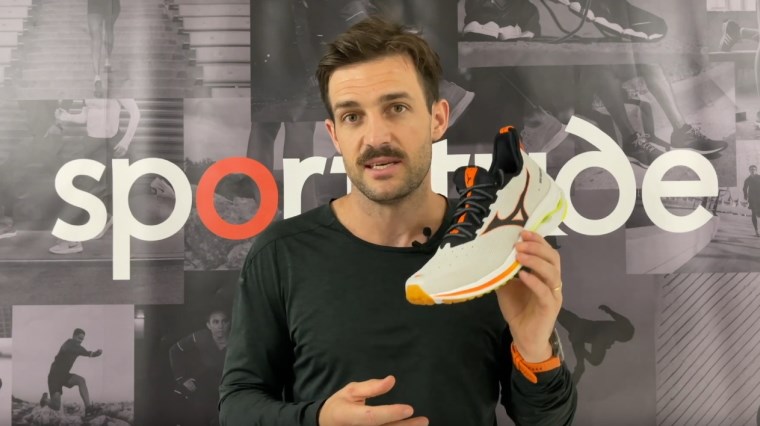
There you have it, the Mizuno Wave Rider Neo. In wrapping things up with this shoe, it is a lighter shoe than the Wave Rider 24 by roughly 10 grams in the men's on our scales at Sportitude.
It’s really dialling in on the performance of this shoe. Being lighter and softer underneath the foot ensures it's a really pleasurable ride. I like it when brands do make a slightly lighter version of a shoe.
We're all screaming out for less effort with our road running shoes and when they execute a midsole that's slightly softer too, you get more confidence.
When I put this shoe on, I like how it feels underneath the foot. The Wave Enerzy foam is pure and plush with plenty of response through that forefoot as well.
If you have any questions on the Wave Rider Neo please contact our Sportitude shoe experts. If you haven't already, please subscribe to the Sportitude YouTube channel, hit the red button and hit the notifications bell so you can keep up to date with everything that's going on in the running shoe space in Australia.
Until next time stay safe, happy running and we'll see you out on the road. Take care.
FEATURES
Mizuno Wave Rider Neo
- Support: Neutral
- Midsole: Mizuno Enerzy
- Heel Height: 30mm
- Forefoot Height: 18mm
- Offset / Drop: 12mm
Men
- Weight: 270g / 9.5oz
- Widths: D (standard)
Women
- Weight: 225g / 7.9oz
- Widths: B (standard)
Mizuno Wave Rider 24
